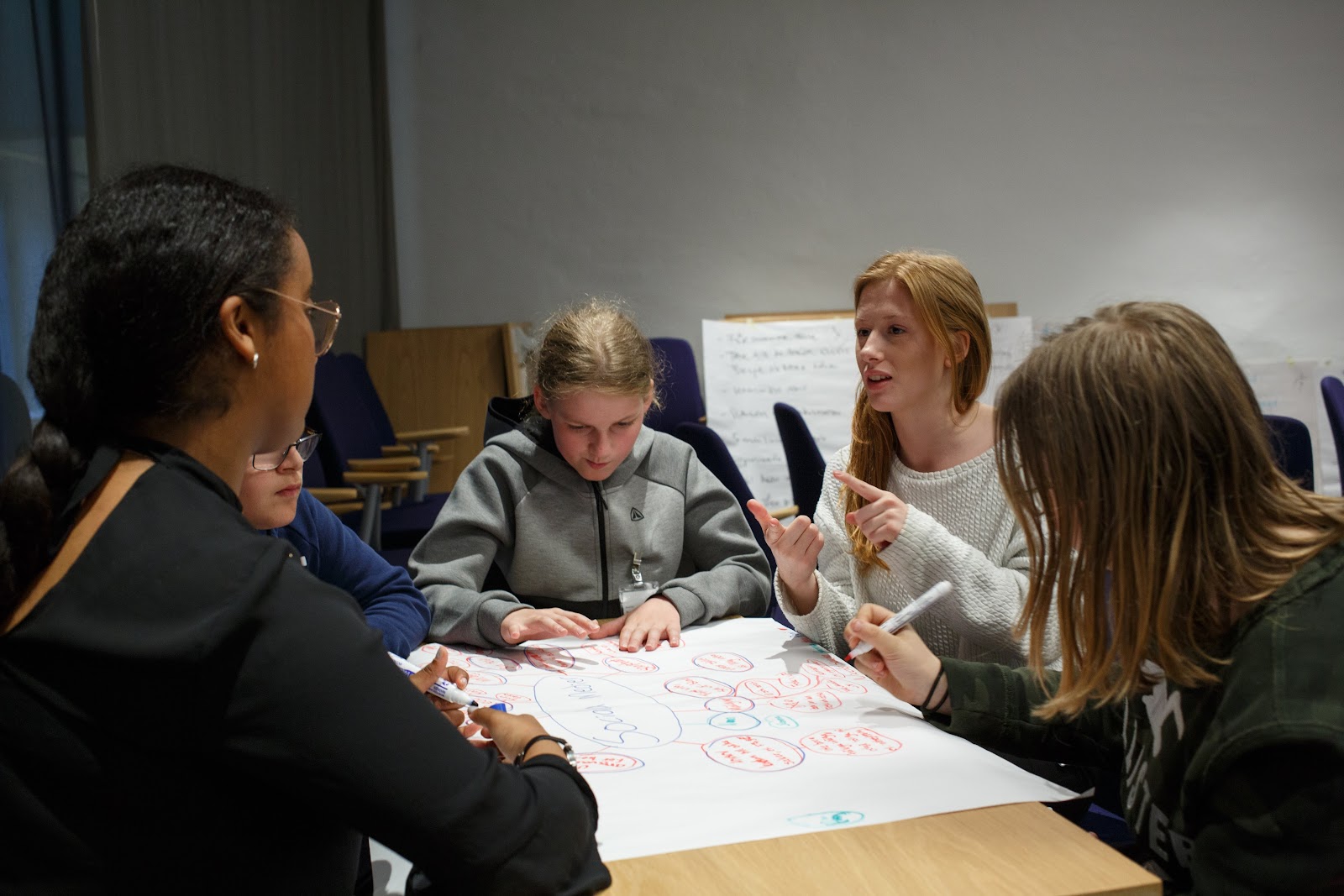CREATE-ing Together: Using Perusall and the C.R.E.A.T.E method for increasing reading comprehension and analysis of primary literature
Combining the C.R.E.A.T.E .method with an online annotation and discussion tool like Perusall can empower students to confidently participate in conversations and amplify more voices in the classroom. Together they may lead to deeper knowledge building and synthesis among communities of learners.
What is C.R.E.A.T.E.?
The C.R.E.A.T.E. method for reading primary literature is a teaching methodology that aims to engage undergraduate students in the analysis of scientific literature. C.R.E.A.T.E. is the acronym for the process of “Consider, Read, Elucidate hypotheses, Analyze and interpret data, Think of the next Experiment” that is the foundation of the method (teachcreate.org). Although the authors suggest reviewing a series of articles from the same laboratory or research group to create a module that follows the consistent research of a single question they also acknowledge the same method can be used to analyze free-standing articles about the same topic, or to compare popular media articles to primary literature. There are multiple applications for the entire process but the main focus is to help students break down papers into their most basic components and then use tools to understand those components such as summarizing key points, drawing mindmaps, or even cartoons and comics. Students therefore actively translate the research literature into a language they understand and can bring to classroom discussions.The Role of Perusall
Perusall is a browser-based document annotation tool that allows learners to collectively read, annotate, comment, discuss, and question an assigned reading. We’ve discussed it on this blog before (READ: Promote Active Learning and Authentic Discussion with Perusall by guest blogger Brendan Lake). Persuall’s integration with Canvas and other LMS, makes it an ideal tool for discussions in online and flipped classrooms. In incredibly large classrooms, Perusall readers can even be divided into groups for a smaller cohort experience.As Clarke (2019) points out, “Instructors routinely and reasonably express frustration when students choose not to complete required reading assignments. Readings are chosen because they are important, and the decision to not engage with course texts effectively hamstrings the creative potential for course meetings. As a result, many instructors work diligently to incentivize students reading rates” (p.1). Perusall allows instructors to incentivize reading by measuring the amount of time spent reading a page, the number of thoughtful comments a student provides (yes, they measure thoughtfulness), and their interaction with peers.
Why would we want to combine the two?
Perusall, for all of its engagement, still has the potential for students to figure out a specific recipe of response that allows students to highlight and passively engage by writing verbose nonsense that hints at the knowledge contained in a particular reading. The C.R.E.A.T.E. method, however, assists the instructor in assigning a list of outcomes to a reading assignment. It tells students not just that they should “read” but what they should do to operationalize the knowledge in the reading.
How can we combine the results from the C.R.E.A.T.E. Method with the technology-empowered reading system Perusall? Think of it as “CREATE-ing Together”.

 Post author:
Post author:
How can we combine the results from the C.R.E.A.T.E. Method with the technology-empowered reading system Perusall? Think of it as “CREATE-ing Together”.
Let’s examine the aspects of C.R.E.A.T.E. and how Perusall could be applied to each.
Ideas adapted from Table 1 in Hoskins et al (2011).
- Consider
Have students note the major topics for review or identify variables throughout the paper that should be discussed. They can do this through annotations, but also through keeping a private notebook of their experience with the paper [see: Private Notes]. Perhaps encourage students to do a read of the paper solo and write out their thoughts and concerns before they return to annotate. Encourage the use of Perusall’s upvoting feature, or comment replies to have students expand upon the work of their peers. - Read
Have students collectively highlight unfamiliar words and research (and cite) definitions. Again up-voting the most relevant information from their peers. Have them re-write descriptions of relevant tables and graphs in their own words, or ask questions about them. C.R.E.A.T.E. encourages students to get creative here by using concept maps, cartoons, and other doodles. Perusall easily does this by allowing students to post images directly in their comments. However, they may need to use another application to generate images like Google Drawings. - Elucidate Hypothesis
Encourage students to highlight the hypothesis and restate it in their own words. Perhaps they can make predictions about how such a hypothesis should be tested. Remind students to review any figures and annotate how they relate to the hypothesis at hand. Which part of the question are they trying to answer? Upvote and respond to peers answers. - Analyze and Interpret Data
Have students use their work so far about charts, hypotheses, and commentary and diagrams to review the generated data. Hoskins et al. (2011) recommend that students determine if there is logic from the hypothesis to the experiment, and the data produced. Up-voting annotations about this, prompting students to consider these questions, or having students contribute multiple drawn concept maps may be helpful. For students that will meet face to face the final map could be collaboratively made in person. For those in remote or online courses collective mapping may be an assignment that concludes and follows the Perusall activity. - Think of next experiment
Engage students in forward thinking. Perhaps prompt them at the end of the article about how they would follow up with the study as presented. Are there new or different questions that arise because of the conclusions presented. Are there parts of the hypothesis that could be tested in different ways? Again, this could be done within Perusall at the end of the document, or through a follow up with classroom discussion once students have done steps 1-3 on their own.
Other suggestions for combining the C.R.E.A.T.E. Method and Perusall
- Organize your readings in Perusall around a research question or topic. This may include papers from the same lab, or different papers, and popular media articles across a topic. [Of relevance: How to assign multiple documents, and How to create, edit, or delete an assignment]
- Typically, most of the steps of C.R.E.A.T.E. are meant to be done ahead of class discussion, but with the application in Perusall we may do some parts simultaneously. Decide if you will keep the full experience of discussion within Perusall, or use the work done on C.R.E.A.T.E. through Perusall to fuel further discussion in discussion threads in a Learning Management System, or via face-to-face or remote synchronous discussions. Communicate your expectations and plans to students.
- Consider using Perusall’s features, like Hashtag, to create a tagging architecture that relates to the C.R.E.A.T.E. process, it may be useful to provide students with a hierarchy of tags, or agree upon them as a class before the first assignment. This will prevent a flood of un-curated tags that bloat your reading process.
- Decide if you will prompt students about specific aspects of the paper. Instructor comments show up in blue so they are easily found by students. [Instructor commenting and questions in Perusall]
Works Cited
- Clarke, A. J. (2019). Perusall: Social learning platform for reading and annotating (perusall LLC, perusall.com). Journal of Political Science Education, 1–6. https://doi.org/10.1080/15512169.2019.1649151
- Hoskins, S. G., Lopatto, D., & Stevens, L. M. (2011). The C.R.E.A.T.E. approach to primary literature shifts undergraduates' self-assessed ability to read and analyze journal articles, attitudes about science, and epistemological beliefs. CBE life sciences education, 10(4), 368–378. https://doi.org/10.1187/cbe.11-03-0027
- Welcome to Teach C.R.E.A.T.E. (n.d.). Teach C.R.E.A.T.E. Retrieved June 11, 2020, from https://teachcreate.org/
Lenora Ott is an instructional designer in the Center for Evolution and Medicine at Arizona State University. Lenora assists faculty with developing and launching their online courses and provides long term evaluation, redesign, and support for online coursework. Her passion is empowering faculty to create meaningful learning experiences for their students and themselves online. She has worked in higher education for 7 years and has a Master of Science in Global Technology and Development from Arizona State University and a Graduate Certificate in Educational Technology from Northern Arizona University.

Comments
Post a Comment